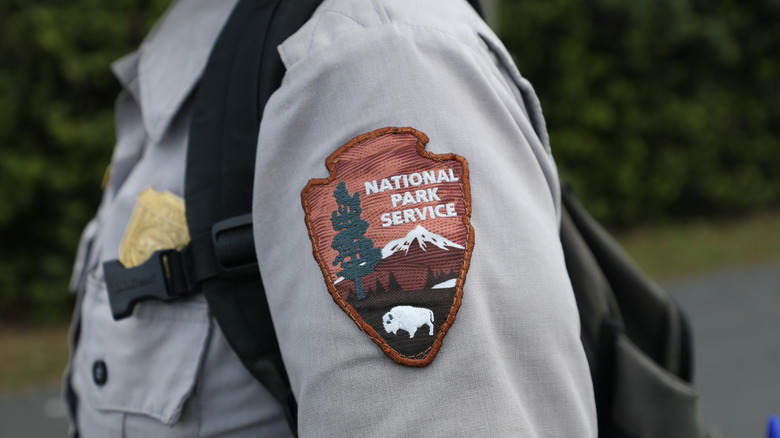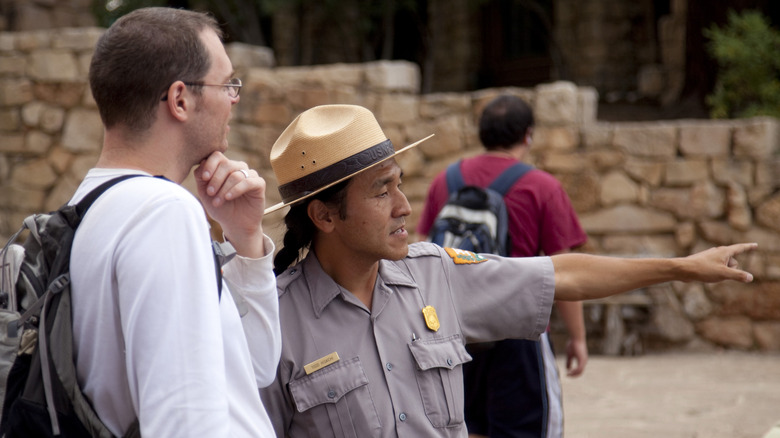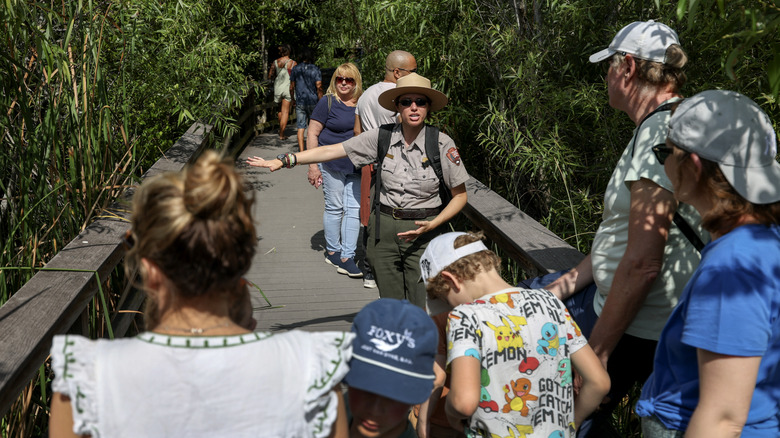If A Park Ranger Asks You Questions About Your Hike, Here's What It Really Means
Even though no one thinks that they'll be the hikers to get lost in the forest or injured, it could happen to anyone. National parks in the United States host over 300 million people per year. And while deaths are rare (about 240 per year), most of them are preventable with a bit of foresight, planning, and proper knowledge. This is where park rangers and the National Park Service's Preventive Search and Rescue (PSAR) project come into play. If a friendly park ranger ever approaches you before a jaunt, they're following the protocol meant to keep park-goers safe and prevent accidents from happening.
PSAR is a much-needed program that was developed in response to increasing search and rescue emergencies (SARs) within national parks from the early 1980s to the late 1990s. In 1996, park rangers set out on 482 SAR missions — double the number from 1983. And while it's impossible for park rangers to guarantee safety across all of the country's vast 63 parks and over 400 National Parks-managed lands, we can certainly all do our part to lighten the load. The best way to do this is to act preventatively.
To that end, PSAR has tried to educate people regarding all the reasons folks usually get hurt or go missing in national parks, such as heat-related deaths and swimming accidents. Launched in the Grand Canyon in 1997, the program has evolved quite a bit and now incorporates teams of patrolling volunteers and modern mapping tech. But, there's no substitute for a face-to-face chat between trekker and ranger.
What kind of questions you should expect from a park ranger?
The reader could probably guess some of what a park ranger might ask, like, "Do you know the area?" or "Have you hiked here before?" But rather than ask questions willy-nilly, an encounter with a park ranger follows a certain strategy that's part of the National Park Service's Preventive Search and Rescue protocol. Procedures help rangers keep accurate data about what they and visitors have said and done, which provides better analyses and, therefore, better overall safety.
For instance, park rangers fill out daily patrol logs to record their interactions with visitors. These logs include the trail where the encounter occurred, the patrol's start and end times, and the type of contact with a visitor (e.g., preventive action, hiker assist, or major medical). A preventive action centers on education and correcting potentially injurious behaviors or choices. A park ranger might make sure you have enough water for whatever your hike is, check to see if your clothing or gear is adequate for the task, and, as mentioned, see if you know the area. And yes, rangers have to tally and record each and every time they talk to someone face-to-face.
You might make yourself better prepared simply by thinking of questions that a park ranger might ask you. If and when you meet any on the trail, make sure to keep their duties in mind and give them a hearty thank you before continuing on your way.
How the National Park Service's Preventive Search and Rescue helps keep park-goers safe
The National Park Service's Preventive Search and Rescue (PSAR) focuses on types of activities that tend to result in injury or death. In 2010, it necessitated permits for climbing Half Dome, one of Yosemite National Park's more dangerous trails, because of deaths due to overcrowding. Park rangers also educate people about swimming safety, as drowning is actually the most common cause of death at national parks.
Lake Mead National Recreation Area is surprisingly the deadliest in the U.S., so visitors might want to avoid swimming in it or even skip it entirely for nearby Lake Mohave. Heat-related issues are also a concern for PSAR, especially if people push themselves past their capabilities or trek through the Grand Canyon's brutal heat. By the mid-2010s, rangers regularly walked through parks handing out pamphlets to visitors as part of PSAR's "STOP, Heat Kills" campaign, which later became "Hike Smart."
Now, PSAR rangers are their own type of ranger. They are certified EMTs who patrol national parks or often station themselves near bottlenecks that visitors are likely to pass through. The program also conducts safety analyses using metrics like weather data, trail hours, patrol times, and hikers helped. Some hikers know what they're doing, but many do not. Park rangers are doing their due diligence by making sure that no one takes unnecessary risks while trying to enjoy themselves in nature.


